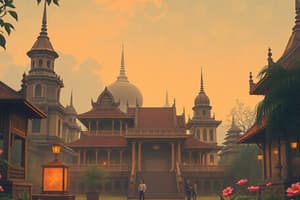Podcast
Questions and Answers
What was a significant effect of British colonial rule in Myanmar?
What was a significant effect of British colonial rule in Myanmar?
- It promoted local cultures and traditions.
- It eliminated nationalist sentiments among the people.
- It introduced more democratic forms of governance.
- It led to the exploitation of the country's resources. (correct)
Who was a prominent leader of the nationalist movements in early 20th century Myanmar?
Who was a prominent leader of the nationalist movements in early 20th century Myanmar?
- Bogyoke Aung San
- U Nu
- General Ne Win
- Aung San (correct)
What was the nature of Saya San's actions in the 1930s?
What was the nature of Saya San's actions in the 1930s?
- He focused on social reforms without political involvement.
- He initiated a peasant rebellion against British rule. (correct)
- He collaborated with the British administration.
- He organized peaceful protests against colonial rule.
What does the resistance against British colonial rule in Myanmar indicate about local sentiments during that period?
What does the resistance against British colonial rule in Myanmar indicate about local sentiments during that period?
What was a key outcome of Saya San's rebellion in the 1930s?
What was a key outcome of Saya San's rebellion in the 1930s?
What was the purpose of the Anti-Fascist People's Resistance League (AFPFL)?
What was the purpose of the Anti-Fascist People's Resistance League (AFPFL)?
Which year did Myanmar achieve independence from Britain?
Which year did Myanmar achieve independence from Britain?
What major challenge did Myanmar face after gaining independence?
What major challenge did Myanmar face after gaining independence?
Who played a pivotal role in the fight for Myanmar's independence?
Who played a pivotal role in the fight for Myanmar's independence?
What was a significant threat to national unity in Myanmar after independence?
What was a significant threat to national unity in Myanmar after independence?
Flashcards
British Colonial Influence on Myanmar
British Colonial Influence on Myanmar
Myanmar, previously known as Burma, experienced a significant transformation under British rule due to the imposition of colonial administration, suppression of local cultures and exploitation of resources.
Nationalist Sentiments in Myanmar
Nationalist Sentiments in Myanmar
The British colonial rule in Myanmar led to the development of nationalist movements aiming for self-governance and independence, demonstrating a desire for individual control over their destiny.
Saya San's Rebellion
Saya San's Rebellion
Saya San, a prominent figure in early 20th century Myanmar, led a peasant rebellion against British rule, highlighting the growing discontent and desire for freedom from colonial control.
Saya San's Rebellion's Impact
Saya San's Rebellion's Impact
Signup and view all the flashcards
Aung San's Role in Independence
Aung San's Role in Independence
Signup and view all the flashcards
What was the AFPFL and why was it formed?
What was the AFPFL and why was it formed?
Signup and view all the flashcards
When did Myanmar achieve independence and what challenges did it face?
When did Myanmar achieve independence and what challenges did it face?
Signup and view all the flashcards
What internal conflicts threatened Myanmar's national unity after independence?
What internal conflicts threatened Myanmar's national unity after independence?
Signup and view all the flashcards
How did the AFPFL contribute to Myanmar's independence?
How did the AFPFL contribute to Myanmar's independence?
Signup and view all the flashcards
What was the main challenge impacting Myanmar's nation-building after independence?
What was the main challenge impacting Myanmar's nation-building after independence?
Signup and view all the flashcards
Study Notes
Myanmar's History
- Myanmar, formerly Burma, has a history marked by foreign rule and indigenous resistance.
- Colonial rule by Britain significantly impacted Myanmar's national identity and development of nationalist sentiments.
- British colonial rule suppressed local cultures and exploited resources, fostering resentment for self-determination.
- Nationalist movements emerged in the early 20th century, led by figures like Saya San.
- Saya San led a peasant rebellion in the 1930s against British rule, though it was ultimately suppressed.
- This rebellion was a turning point in the fight for independence.
- Aung San played a crucial role in the fight for independence.
- Aung San formed the Anti-Fascist People's Resistance (AFPFL) in 1944.
- The AFPFL was a coalition of various political parties and ethnic groups united against Japanese occupation.
- The AFPFL cooperated with Allied forces to liberate Myanmar from Japanese rule.
Independence and Challenges
- Myanmar gained independence from Britain in 1948.
- Significant challenges to nation-building included ethnic tensions (Burmese majority versus minority groups like Shan, Karen, and Kachin).
- The military significantly impacted Myanmar's politics, often clashing with ethnic minorities and suppressing dissent.
- Ongoing civil wars in various parts of Myanmar resulted from these conflicts.
Nationalism and its Impact
- Nationalism remains a powerful force in shaping Myanmar's political landscape and social dynamics.
- While it united the country against foreign domination, it also exacerbated ethnic divisions and conflicts.
- The struggle for democracy and human rights in Myanmar is intertwined with its national identity and aspirations.
Studying That Suits You
Use AI to generate personalized quizzes and flashcards to suit your learning preferences.



